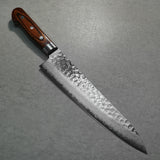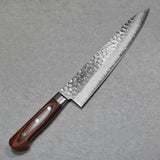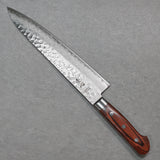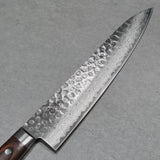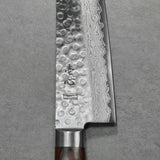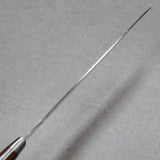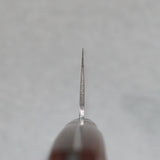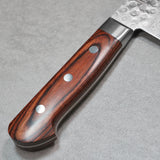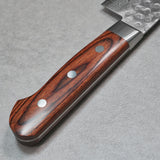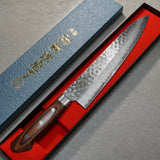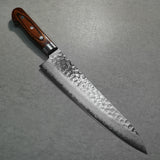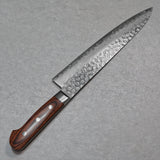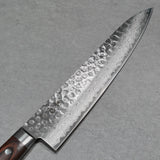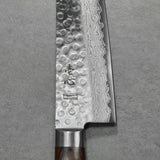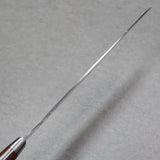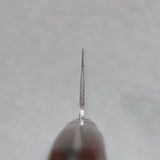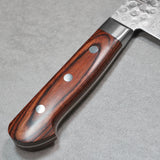Isshin Hammered 17 Layers Damascus VG10 Chef Knife 240mm
Brand: Isshin Hamono (一心刃物)
Type: Gyuto / Chef Knife (Double Bevel)
Blade Material: Hammered(TSUCHIME) 17 Layers Damascus Stainless Steel
Core: VG10 (Cobalt Alloy Stainless Steel)
Blade Length: 240 mm (9.4'')
Total Length: 375 mm (14.7")
Thickness of Spine: 2 mm
Blade Width: 51 mm (2")
Weight : 250 g (8.8 oz)
Handle: Reinforced Laminated Wood
Made in Japan
The elegant wave pattern, commonly known as "Sumi Nagashi," is one of the treasures produced by Japan's cutlery tradition. Inspired by the craftsmanship of Japanese swords (Katana), the blade is constructed from a combination of high- and low-carbon stainless steel, with 17 layers. The hammered design (Tsuchime) not only enhances the blade’s appearance but also adds a sense of luxury, showcasing the beauty of Japanese craftsmanship. The blade's design helps release ingredients as you cut, making it a durable and versatile kitchen knife suitable for both home and professional use.
The blade shape is called "HAMAGURI-BA" in Japanese. "HAMAGURI" means clam, and "BA" refers to the blade or edge. This shape allows the knife to cut ingredients smoothly and its provides strength and durability.
The edge is exceptionally sharp—so sharp it can even shave downy hair!
Made from VG-10, a high-carbon stainless steel containing cobalt, this steel is known for its excellent sharpness and wear resistance. It is favored by professionals and is produced by Takefu Special Steel Co., Ltd., a renowned Japanese company. if the entire blade is very hard, it is difficult to sharpen. The other case, if the blade is soft, it is dull, and the sharpness falls immediately. That is why this hard material is used in the centrr for superior edge retention, while softer steel is used along the side to allow for easier sharpening. Because its hardness, ceramic sharpening stones are recommended for maintaining the blade's edge.
Take a look at our Ceramic Sharpening Stone.
NOTE:
The core steel is VG10, and the side steel is rust-resistant; however, please be sure to wash, wipe, and dry the knife thoroughly after each use. If rust appears on the blade, use a cleanser or take it to a sharpening service (note that scratches may occur).
Avoid twisting the edge or striking the blade. Do not cut frozen foods or bones, as the thinner, sharper edge of Japanese knives may chip or break. Since Japanese knives are handcrafted, slight scratches may appear naturally.
The manufacturer is located in Seki City, Gifu Prefecture, a region renowned worldwide for its cutlery production. Today, approximately 70% of Japan's cutlery is made in Seki.
Then he forged first japanese sword over there for the first time at that time. Over time, many master craftsmen emerged from Seki, establishing the city as a hub for swordmaking.
As the world changed, the demand for swords began to decline about 300 years ago. Some swordsmiths turned to agricultural tools, such as sickles and kitchen knives, to sustain their craft.
In 1876, the Japanese government issued a decree banning the wearing of swords. As a result, many swordsmiths shifted their focus to making practical home knives. At the same time, the production of pocket knives were introduced into Europe and America.
Seki's forged cutlery was first exported to Korea in 1894, and pocket knives began shipping to Canada in 1897. In 1919, metal western-style tableware (spoons, knives, forks) was introduced, followed by the production of razors in 1932. Prior to World War II, exports to Southeast Asia were also active.
After the Second World War, Seki continued to expand its production, creating kitchen knives, scissors, pocket knives, nail clippers, razors, tableware, and outdoor knives. These products were exported to countries around the world, including the United States and Europe. The city gained international recognition, earning praise alongside other world-famous cutlery centers such as Solingen (Germany) and Sheffield (United Kingdom), collectively known as the "3S" of cutlery.
What sets Seki's cutlery production apart is its focus on small-batch manufacturing, continuously innovating with modern designs while maintaining traditional craftsmanship techniques.
























